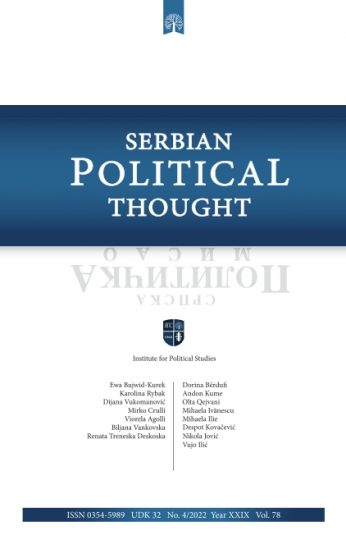Main topic
Serbian Political Thought
Media and Democratic Control Over the Armed Forces In the Republic Of Serbia
Abstract
State institutions (all three branches of government) have an important role in democratic control of the armed forces, together with civil society institutions among which the media, referred to as “the fourth branch of government” or “the watchdogs of democracy”, play the most important role. The armed forces need the media in order for them to inform the public about their role in society, educate the public on the issues of defense and security, as well as enable easier access to current events. For the majority of people in Serbia the media are the main source of information about what happens in society, and they influence public opinion to a great extent. However, previous research of the relations between the media and the armed forces in Serbia referred exclusively to the analysis of media content, while the media’s attitudes and knowledge of democratic control were not included. In this paper, based on the results of a pilot project carried out in 2013, we will present the extent of knowledge Serbian media have about democratic control of the armed forces, how the media evaluate their relations with the Ministry of Defense, and the basic obstacles the media encounter while exercising democratic control in practice.
References
- Anderson, P., Ward, G. (eds.) (2007) “The Future of Journalism in Advanced Democracies. Aldershot: Ashgate Publishing Limited.
- Atlantic Council of Serbia (2008) “Serbian public on security sector”, project realized with the support of the OEBS Mission in Serbia (online) Available at: at www.atlanticcouncil.rs/?str=arhiva2008 (Accessed 11 July 2013).
- Balkan Monitor (2010) “Insights and Perceptions: Voices of the Balkans, Summary of Findings”. Brussels: Gallup.
- Beogradski centar za bezbednosnu politiku (2012) „Građani i dalje imaju najviše poverenja u vojsku“ (online). Available at: http://www.bezbednost.org/Vesti-iz-BCBP/4667/Gradjani-i-dalje-imaju-najvise-poverenja-u-vojsku.shtml (Accessed 13 December 2013).
- Bjelajac, M. (1988). “Vojska Kraljevine SHS 1918-1921”. Beograd:Narodna knjiga.
- Bojović, M. (1999) “Vojska pred očima javnosti”. Beograd: Novinsko-informativni centar Vojska.
- Caparini, M. (2004a) “Media and the security sector: oversight and accountability” in Caparini, M. (ed) “Media in Security in Governance”. Geneva: BICC/DCAF.
- Caparini, M. (2004b). “Civil society and democratic oversight of the security sector: a preliminary investigation” Working Paper- 132. Geneva: DCAF.
- Caparini, (2010) ““Security Sector Reform and the News Media”. In Fluri, P. (ed.) “News Media and SSR”. Geneva and Brussels: DCAF. p. 11.
- Center for Democracy and Governance Bureau for Global Programs, Field Support, and Research S. Agency for International Development Washington, D.C. (1999) “Role of Media in Democracy: A Strategic Approach” (online). Available at: https://www.usaid.gov/sites/default/files/documents/2496/200sbc.pdf (Accessed 13 January 2014).
- Council of Europe (1999) “Recommendation 1407 (1999) Media and Democratic Culture“ (online). Available at: assembly.coe.int//Main.asp?link=http://www.assembly.coe.int/Documents/AdoptedText/ta99/erec1407.htm#1 ( Accessed 17 Jun 2014).
- Cottey, A., Edmunds, T., Forster, A. (2002) “The Second Generation Problematic: Rethinking Democracy and Civil-Military Relations”. Armed Forces & Society, 29: p. 41.
- Cunningham, T. (2010) “Strategic Communication in New Media Sphere”, Joint Forces Quarterly, 59 (4): 111-114.
- Ebart – An Online Database of Serbian Video Archives and Print Media (2009) (online) Available at: http://www.arhiv.rs/novinska-pregled/2009/cela-godina/ceo-mesec/vojska/sve-novine/pregled/ (Accessed 15 January 2014).
- Ebart – An Online Database of Serbian Video Archives and Print Media (2010) (online) Available at: http://www.arhiv.rs/novinska-pregled/2009/cela-godina/ceo-mesec/vojska/sve-novine/pregled/ (Accessed 19 January 2014).
- Ebart – An Online Database of Serbian Video Archives and Print Media (2011) (online) Available at: http://www.arhiv.rs/novinska-pregled/2009/cela-godina/ceo-mesec/vojska/sve-novine/pregled/ (Accessed 22 January 2014).
- Ebart – An Online Database of Serbian Video Archives and Print Media (2012) (online) Available at:
- http://www.arhiv.rs/novinska-pregled/2009/cela-godina/ceo-mesec/vojska/sve-novine/pregled/ (Accessed 22 January 2014).
- Hadžić, M. et al (2009) “Yearbook of Security Sector Reform in Serbia“. Belgarde: Centre for Civil-Military Relations.
- Hiebert, R. (1991) “Public Relations as a Weapon of Modern Warfare,” Public Relations Review, 17 (2): 108.
- Homan, K. (2013) “Civilian Control of the Military”. In: Kayhan, M, Hartog, M. (eds.) “Promoting Good Governance in the Security Sector: Principles and Challenges”. Groningen:The Centre of European Security Studies. p. 92.
- Klopfer, F. et al (eds.) (2012) “Almanac on Security Sector Oversight in Western Balkans. (Belgrade: DCAF & Belgrade Centre for Security Policy.
- Mallick, P. K. (2009) “Military-media relations: Can the media be a force Multiplier?”, AIR POWER Journal, 4(4): 125.
- Matić, J. (2007) ““Media Coverage and the Reform of the Military”. In: Hadžić, M. (ed.) “The Reform of the Security Sector in Serbia”. Beograd: CCVO. pp. 33-37.
- Mayfield, T. (2011) “A Commander’s Strategy for Social Media”, Joint Forces Quarterly, 60 (1): 79-83.
- Milošević, M. (2000) „Glas strpljivih“ Vreme broj 515, (online) Available at: http://www.vreme.com/arhiva_html/515/09.html (Accessed 2 December 2013).
- Ministarstvo odbrane Republike Srbije (online) „Službeni vojni list“ Available at: http://www.mod.gov.rs/cir/4351/sluzbeni-vojni-list-4351
- Moskos, C. et al (2000) “ The Postmodern Military: Armed Forces After the Cold War”. New York, NY: Oxford University Press.
- NATO Strategic Communications Policy (2009) (online) Available at: http://publicintelligence.net/nato-stratcom-policy/ (Accessed 16 November 2013).
- Radišić, S. (2012) „Vojska Jugoslavije i mediji“ (online) Available att http://dzonson.wordpress.com/2012/04/23/svetozar-radisic-vojska-jugoslavije-i-mediji/ (Accessed 11 July 2013).
- Rikveilis, A. (2012) “Practice of Social Media in Military: Success Undeniable, Future Uncertain – A View from Latvia” NATO RESEARCH AND TECHNOLOGY ORGANISATION (online) Available at: rta.nato.int/public//PubFullText/RTO/…MP…///MP-HFM-201-09.doc (Accessed 11 December 2013).
- Rokvić, V., Ivaniš. Ž. (2013) “Parliamentary Oversight of the Security Sector in Serbia Perceived Effects”. PROBLEMS OF POST-COMMUNISM, 60(1): pp. 55-61.
- Rokvić, V. (2012) „Parlamentarna kontrola sektora bezbednosti u Republici Srbiji“. Beograd: Fakultet bezbednosti.
- Rokvić, V. et al. (2013) “Civi-Military Relations and Democratic Control over the Armed Forces in the Republic of Serbia“, Armed Forces & Society, 39 (4): 675-694.
- Slavujević, Z., Mihailović, S. (1999) „Dva ogleda o legitimitetu“. Beograd: Institut društvenih nauka.
- Smith, R. (2006) “The Utility of Force: The Art of War in the Modern World”. London: Penguin Books.
- Toffler, A., Toffler, H. (1993) “War and Anti-War, Survival at the Dawn of the 21st Century London: Little, Brown and Company.
- Ross, S. (2006) “(De)Constructing Conflict: A Focused Review of War and Peace Journalism”, Conflict & Communication 5(2): 2.

